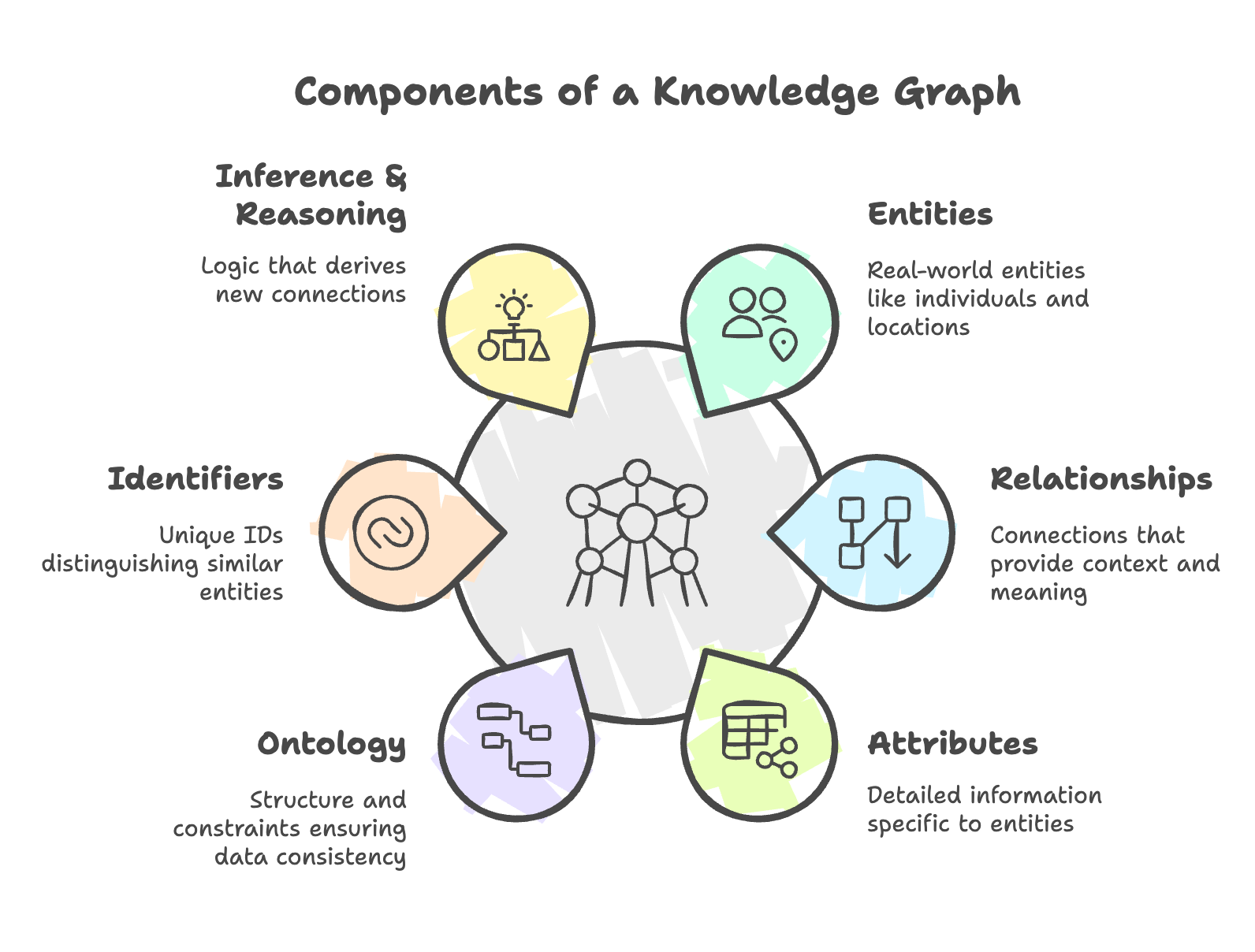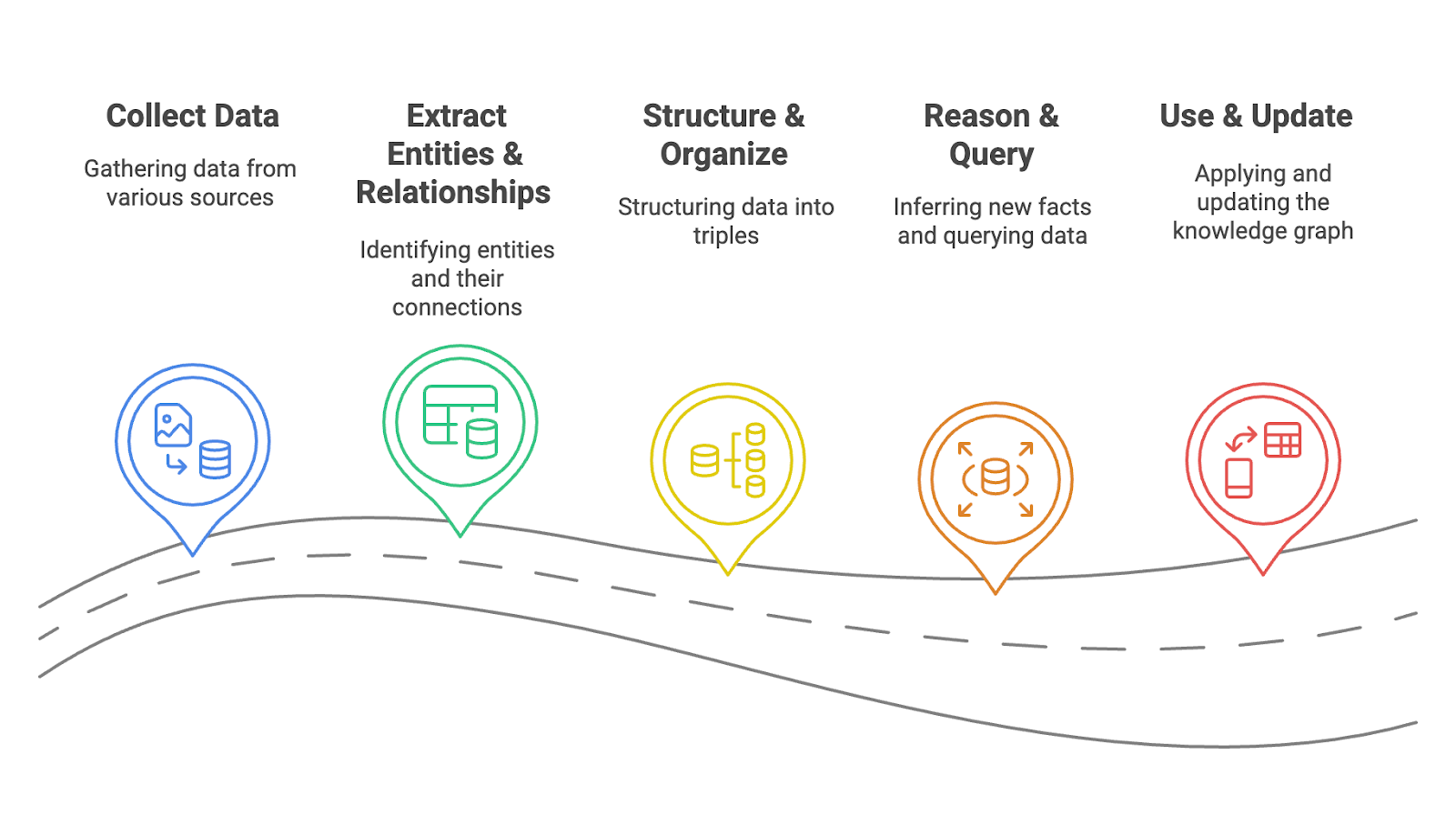RÉSUMÉ
Knowledge graphs rely on entities (nodes), relationships (edges), attributes (properties), ontologies (schema), and inference mechanisms to enable machines to understand and represent information. They work by collecting and processing data, extracting entities and relationships, structuring this information in a graph format, and enabling reasoning and querying for insights. Knowledge graphs are widely used in e-commerce, finance, healthcare, and cybersecurity industries to enhance search functionality, detect fraud, personalize recommendations, and improve decision making.
What is a knowledge graph?
A knowledge graph is a structured representation of information that connects entities, concepts, and the relationships between them in a way that machines can understand and utilize. It organizes data into nodes that represent entities like people, places, or things, and edges that represent their relationships. This creates a semantic network of interconnected information.
Knowledge graphs are used in search engines, recommendation systems, and artificial intelligence (AI) applications to enhance data retrieval, improve contextual understanding, and provide more accurate insights. By leveraging structured data and linking it with existing information, knowledge graphs help machines process and infer knowledge similarly to humans.
Keep reading this resource to learn more about how knowledge graphs work and how to build them.
- Key elements of knowledge graphs
- How do knowledge graphs work?
- Ontologies and knowledge graphs
- Knowledge graph examples
- Knowledge graph use cases
- Knowledge graph benefits
- How to build a knowledge graph
- Principaux enseignements et ressources complémentaires
- FAQ
Key elements of knowledge graphs
Before we dive into how knowledge graphs work, it’s important to explain the elements that make them function. These mechanisms form the foundation of knowledge graphs, enabling them to represent real-world entities, their attributes, and their relationships. By breaking down a knowledge graph into its basic components, we can better understand how it organizes data, facilitates semantic search, and improves AI-driven applications. Below are the fundamental elements that make knowledge graphs powerful tools for structuring and analyzing information.

Entities (Nodes)
Entities are a knowledge graph’s building blocks, containing real-world entities like people, places, or things. An entity is a node holding meaningful information. For example, “Albert Einstein” would be an entity with attributes like birthdate and occupation. Ultimately, entities provide the foundation for meaningful links.
Relationships (Edges)
Relationships are the connections between things, forming edges in the graph. Relationships describe how things relate to each other, for instance, “Albert Einstein” → “was born in” → “Germany.” Relationships provide context for the data and present us with a network of related information.
Attributes (Properties)
Attributes are entity-specific information that provide additional detail about the knowledge graph. “Paris” would have “Population: 2.1 million” and “Country: France” as attributes. Attributes provide important background detail about each entity.
Ontology (Schema or structure)
Ontology dictates the graph’s form and constrains it by specifying entity type and relationships. Ontology helps ensure data consistency by specifying what can be related and how. For instance, it can mandate that “Person” can “act in” a “Movie” but not a “City.”
Identifiers (Unique IDs)
Unique IDs distinguish similar entities. For example, the word “Apple” can denote the fruit and the company, but they both possess unique IDs. The identifiers render the graph correct and prevent confusion.
Inference and reasoning
Inference allows the graph to make new connections from relations. For example, if “John” is the father of “Emma,” and “Emma” is the sister of “Liam,” then the graph can infer that “John” is the father of “Liam.” This reasoning makes the graph intelligent.
These components work together to form an organized, useful body of information, leading to more intelligent search and AI applications.
How do knowledge graphs work?
Knowledge graphs integrate information from diverse sources to create a comprehensive and interconnected network of entities and their relationships. Here’s a breakdown of how they work:

Step 1: Collect data
Knowledge graphs start with data collection from sources like databases, text files, APIs, or websites. The data may be structured (e.g., spreadsheets) or unstructured (e.g., articles). The objective is to collect as much information as possible to build a broad knowledge base.
Step 2: Extract entities and relationships
Next, the system identifies important entities (e.g., people, places, or organizations) and their relationships using techniques like named-entity recognition (NER) and relationship extraction. For example, it might extract that “Barack Obama” is an individual and that he has a relation like “was President of” with “United States.”
Step 3: Structure and organize
Once retrieved, the information is returned in a structured format, typically triples presented as: (Subject, Predicate, Object). An example of this is (Paris, isCapitalOf, France). A schema or ontology is also created to classify entities and relations to be consistent and semantically interpreted.
Step 4: Reason and query
After being organized, the knowledge graph can reason new facts based on logical rules. For example, if “A is a parent of B” and “B is a parent of C,” the graph will be capable of reasoning that “A is a grandparent of C.” Users can query the graph through programming languages like SPARQL to retrieve focused information.
Step 5: Use and update
Finally, the knowledge graph powers search engines, recommendation systems, and chatbots, integrating hybrid search, recherche vectorielleet large language models (LLMs) for smarter, context-aware responses. Regular updates keep it accurate and dynamic for knowledge structuring and access.
This step-by-step process transforms raw data into an interconnected, intelligent web of knowledge.
Ontologies and knowledge graphs
What is an ontology?
An ontology is a formal structure that describes concepts, objects, and their interconnections in a specific area of interest. It provides rules, classes, and categories that help classify and interpret data.
How do ontologies relate to knowledge graphs?
A knowledge graph uses an ontology to structure data, bringing consistency and semantics. The ontology is the backbone of the knowledge graph, specifying how entities are categorized and linked.
Example:
A movie knowledge graph follows an ontology that specifies:
- Actors can act in Movies
- Directors can direct Movies
- Movies can have a Genre
Key differences:
| Fonctionnalité | Ontology | Knowledge graph |
|---|---|---|
| Purpose | Defines rules and relationships | Stores and connects real-world data |
| Structure | Conceptual model (abstract) | Data network (practical) |
| Usage | Provides meaning and reasoning | Enables AI-driven search and analysis |
Knowledge graph examples
Here are some well-known examples of knowledge graphs:
- Google knowledge graph: This knowledge base tightens up search results by learning about relationships between entities (e.g., people, places, or things). It provides direct answers and more detailed, context-sensitive information in search results, such as a knowledge panel for celebrities or landmarks.
- LinkedIn knowledge graph: This knowledge base maps relationships between people, roles, skills, and companies. It helps provide job recommendations, professional relationships, and content based on your profile and network.
- Facebook entity graph: This graph connects users, pages, posts, likes, and interactions to help deliver relevant content and ads. It also improves user experience by recommending relevant posts, groups, and events based on behavior.
- Amazon product graph: This graph organizes product, review, and customer preference information. It powers Amazon’s recommendation engine by suggesting similar or related products through browsing and purchasing history.
Each graph enables a better user experience with personalized, context-aware recommendations.
Knowledge graph use cases
Here are some of the ways knowledge graphs can be used across industries:
- Recommendation systems: E-commerce and streaming platforms use knowledge graphs to personalize recommendations. Amazon suggests products based on user behavior, while Netflix recommends content by analyzing viewing patterns.
- Détection de la fraude et analyse des risques : Financial institutions detect fraud by identifying suspicious relationships and hidden patterns in transactions. Knowledge graphs also help assess credit risk and improve compliance.
- Healthcare and biomedical research: Medical professionals use knowledge graphs to link patient records, drug interactions, and clinical trials. Researchers leverage them to accelerate drug discovery and treatment innovation.
- Cybersecurity and threat intelligence: Cybersecurity teams use knowledge graphs to analyze attack patterns and malicious entities. They help detect threats, identify vulnerabilities, and enhance security defenses.
- Smart assistants and autonomous systems: Self-driving cars and smart cities use knowledge graphs to structure spatial and IoT data, enabling real-time decision making and automation.
Knowledge graph benefits
Knowledge graphs benefit AI applications by enabling them to organize, connect, and reason through complex data. Here are the specific ways they do that:
- Enhanced search and discovery: Knowledge graphs enable semantic search and intelligent query responses by linking related concepts and inferring connections between pieces of information. This ability improves user experience for web and internal search engines.
- Personalization: Knowledge graphs enable personalization by understanding users’ behavior and tastes. This capability allows applications to make personalized recommendations and improve targeted advertising efforts.
- Natural language processing (NLP): Knowledge graphs enable NLP applications like entity recognition, question answering (QA), and text summarization. These features allow machines to understand and generate human-like answers, enhancing chatbots and virtual assistants.
How to build a knowledge graph
Building a knowledge graph involves the following steps:
1. Define purpose and scope: Identify the domain, key entities, and relationships relevant to your application.
2. Collect and process data: Collect structured (databases and APIs) and unstructured (documents and text) data, then cleanse and normalize it.
3. Identify entities and relationships: Use NLP to identify key concepts in your data, then structure them in a graph format.
4. Store in a graph database: Store and manage relationships in your data with databases like Neo4j or Amazon Neptune.
5. Query and analyze: Use languages like Cypher, Gremlin, or SPARQL to gain insights and discover patterns in your data.
6. Visualize and deploy: Use software like Gephi, Linkurious, or GraphX to visualize data relationships and deploy them into applications.
Principaux enseignements et ressources complémentaires
In this resource, we learned that:
- Knowledge graphs structure data into entities and relationships to improve search functionality, enhance AI applications, and aid decision making.
- Knowledge graphs power search engines and recommendation systems, allow financial institutions to detect fraud, enable medical professionals to improve patient care, and help cybersecurity professionals detect vulnerabilities and enhance security.
- Building a knowledge graph involves defining scope, collecting data, identifying entities, utilizing graph databases, querying insights, and visualizing results.
- Graph databases like Neo4j and Amazon Neptune are commonly used for storage and analysis.
- Cypher, Gremlin, or SPARQL are used for querying, while visualization tools like Gephi and Linkurious help explore relationships.
To learn more about concepts related to AI, you can review our hub and check out the resources below:
Ressources complémentaires
- From Concept to Code: LLM + RAG With Couchbase
- How Generative AI Works With Couchbase
- A Guide to LLM Embeddings
- Knowledge Base Population (KBP) – The Stanford Natural Language Processing Group
FAQ
What is a knowledge graph in AI? In AI, a knowledge graph is a structured representation of data that connects entities, concepts, and their relationships to enable machine understanding, reasoning, and decision making.
What are knowledge graphs used for? Knowledge graphs are used to improve search, recommendation systems, data integration, artificial intelligence, and automated reasoning.
What is the difference between graph databases and knowledge graphs? Graph databases store and manage connected data using nodes and edges, while knowledge graphs add semantic meaning by incorporating ontologies, relationships, and contextual understanding for intelligent reasoning.
What is a triplestore? A triplestore is a database designed to store and manage data in subject-predicate-object triples, which enables efficient querying and semantic relationship retrieval in knowledge graphs.
Does ChatGPT use knowledge graphs? Although ChatGPT doesn’t directly use knowledge graphs, it does rely on large language models (LLMs) trained on textual data.